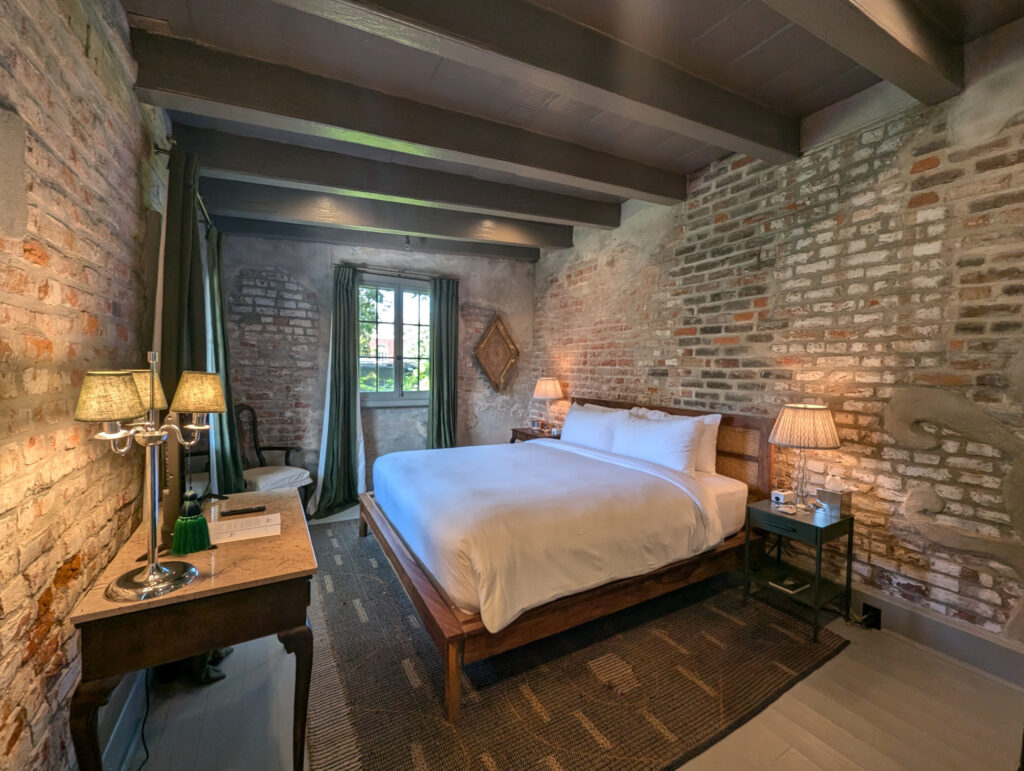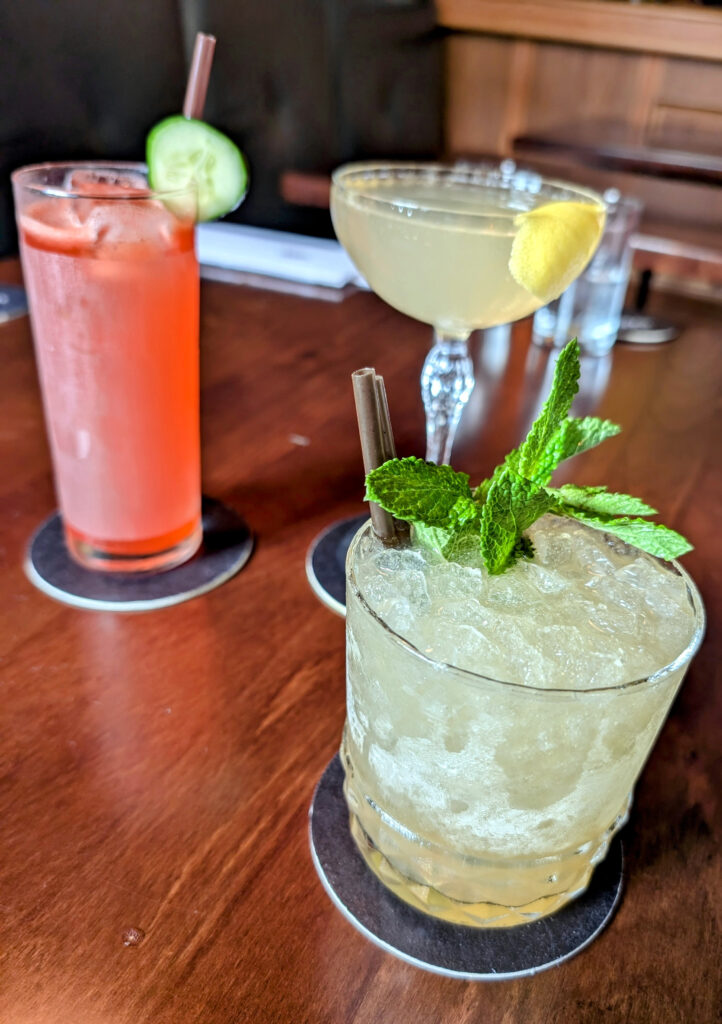In 2023, hôtelier and restaurateur Robért LeBlanc of LeBlanc + Smith collaborated with CureCo founder Neal Bodenheimer, and development partners Talbott Ottinger and Chris Dawson to renovate the Maison De Ville, an 18th century Creole townhouse-turned boutique hotel on Toulouse Street. “It just felt like the right time to reinvest in the French Quarter, salvage a pretty iconic property and tell a fresh story that may re-engage locals,” says LeBlanc. “I think it behooves us to be good shopkeepers and remind the world how magical it is.”
Only a few days after Mardi Gras, the small but storied hotel reopened as The Celestine, with 10 well-appointed guest rooms, and a burbling fountained-courtyard anchored by Bodenheimer’s Peychaud’s, a neoclassical New Orleans cocktail bar honoring its namesake’s signature bitters.
Sara Ruffin Costello, a designer who had worked with LeBlanc + Smith on the collective’s Uptown boutique hotel The Chloe, used a palette of both light and dark greens, terracotta and pale gray, one Costello describes as Caribbean-inspired influences seen through an old world French and Spanish lens. “Everything was about surprise, delight and ultimately calm,” explained Costello. “A sort of haven from the chaos on the streets outside.”

Only steps away from raucous Bourbon Street, this space has long been one of unusual tranquility, a refuge sought out by artists and celebrities ever since the property was converted into a hotel in 1944. Tennessee Williams, one of our country’s foremost playwrights and screenwriters, is among the most notable, a guest who frequently stayed in Room 10, currently The Celestine’s concierge desk and coffee bar.
Today the boutique hotel’s guests and visitors can spend time in the very space where Williams reputedly wrote his most celebrated play, A Streetcar Named Desire. In fact, talk show host Dick Cavett recorded a televised interview with Tennessee Williams at the Maison De Ville, sitting in front of the same fountain that murmurs in the courtyard of The Celestine today.
First built in 1791, the three-story Creole townhouse was originally the home of Jean-Baptiste Lille Sarpy (var. de Lille) and his common-law wife Marie-Josephe “Pouponne” Diaz. Their daughter, Henriette Diaz DeLille lived at 727 Toulouse Street for a brief time, though she strongly opposed her parents’ “left-hand marriage,” an extralegal arrangement of the time between European men and women of color.
In defiance of her parents, DeLille refused to participate in the practice, and turned to God. She spent most of her life educating children of color, and caring for the sick, poor and elderly. A devout Catholic who formed her own congregation called The Sisters of the Presentation, DeLille is undergoing review for beatification with the Holy See, and was named venerable in March 2010 by Pope Benedict XVI.

Later in the mid-19th century, the residence became home to Antoine Amédée Peychaud, a local pharmacist who is the disputed creator of our city’s most famous cocktail the Sazerac, and undisputed inventor of Peychaud’s Bitters. He lived there with his wife Celestine who’s preferred arrangement of her French Quarter home bucked the neighborhood’s trends of the day. “It was customary that the first floor of the building would be a retail space, but Celestine wanted it in a different location than the home,” says LeBlanc. “That’s why we named the hotel Celestine.”
Appropriately refreshed to offer luxury, European-style rooms, The Celestine boasts a melange of antique furniture bought locally at the Lower Garden District’s Merchant House, Dop Antiques on Jefferson Highway, and Mid-City’s Floor 13. Ultimately, one of the largest obstacles to overcome for designer Sara Ruffin Costello came while attempting to unload The Celestine’s new treasures from her car. “Parking truly became the thing, most of my vendors were great about it, [and] most of the meter maids were forgiving. You’d have to orchestrate this ballet of efficiency on the fly.”

Aside from a gorgeous floor-to-ceiling mural in the hotel’s foyer and other touches painted by local decorative artist Diane Killeen, most of the art in The Celestine came from a “treasure trove of discarded art,” old portraits and landscapes discovered in the building’s attic. “I don’t know how long, but it had obviously been tucked away for some time,” says LeBlanc. Scattered all throughout The Celestine’s guest rooms and common spaces, many pieces from the attic’s horde are hanging in Peychaud’s bar. Since art trove’s provenance is a mystery, one of the bartenders has been inventing his own stories about the people and places depicted.

In conjunction with the hotel and bar’s “spirited” history, the guest rooms include mini-bars lavishly supplied with a selection of liquors, mix-ins and snacks. A heady supply of items like small bottles of Sazerac Rye Whiskey, bags of Zapp’s Potato Chips, Starlino Maraschino Cherries, Marcona Almonds and more offer a roaring start to your own in-room party where you can learn how to craft cocktails out of Neal Bodenheimer’s tome Cure: New Orleans Drinks and How to Mix ‘Em available for research on every nightstand. “We wanted to tell a story, you know about the cocktail as a cultural influence,” says LeBlanc. “His [Peychaud’s] impact on cocktail culture in this city is bigger than anyone could give him credit for. Peychaud bitters is the foundation of almost any New Orleans cocktail.”
Beyond the four-poster antique beds draped in luxury linens, whimsical mosaic-tiled bathrooms stocked with Five Wits couture bath and body products, and in-room soaking tubs, The Celestine, at its heart, remains what it has always been; a historic landmark, a home to some of our city’s most celebrated from Mother DeLille to Antoine Amédée Peychaud and Tennessee Williams, a “little enclave” that has drawn high-profile celebrities like Elizabeth Taylor and Michael Jackson. “We don’t really own these buildings,” says LeBlanc. “We have it for one point in time, we’re just stewards.”
*A version of this article was originally published September 2024 in French Quarter Journal



